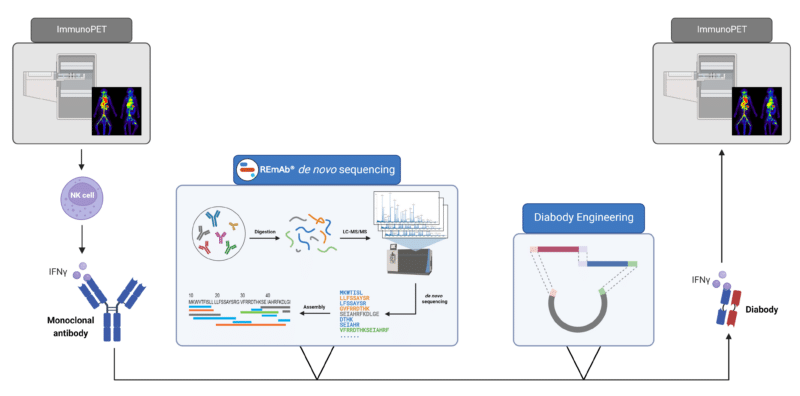Rezazadeh, F., Ramos, N., Saliganan, A-D., Barr, S., Peraino, N., Schomburg, F., Rancour, D., Viola, N. T. (2022). Nucl Med Biol. https://doi.org/10.1016/j.nucmedbio.2022.06.001.
Abstract
Interferon-γ (IFN-γ) is a key effector cytokine with anti-proliferative, pro-apoptotic, and antitumour properties. It is produced by activated T cells, natural killer (NK) cells and natural killer T (NKT) cells in response to a tumour environment. As the production of this cytokine signifies an active immune system, imaging and detection of the IFN-γ biomarker is an effective means of surveying not only its anti-tumour effects but also its immune signaling effects. For example, IFN-y signaling can also increase the expression of the checkpoint receptor programmed death-ligand 1 (PD-L1).
Researchers in the Viola Lab at Wayne State University previously developed a monoclonal antibody (mAb)-based radiotracer for imaging and detection of IFN-γ by immunopositron emission tomography (immunoPET). This imaging agent was developed by labeling a full-length anti-IFN-γ mAb with [89Zr]Zr-DFO-NCS; however, applying full-length mAbs in molecular imaging can pose some challenges. The size of full-length mAbs can limit their tumour penetration capacity and often restrict them to peripheral localization, preventing an accurate depiction of the immune response.
As a result, researchers in the Viola Lab designed, produced, and characterized four diabody (Db)-based radiotracers for IFN-γ targeted immunoPET imaging. Due to their smaller size, Dbs can accumulate rapidly within the tumour, making them an ideal format as an imaging agent. First, they obtained the protein sequence of the commercially available, full-length mAb with Rapid Novor’s REmAb® de novo sequencing service. With this information, they proceeded to generate optimized Db constructs encoding VH-VL domains that are separated by different peptide linker lengths (7-13 amino acids). Further in vitro and in vivo characterization of the 89Zr-radiolabeled Dbs revealed one that demonstrated stable physicochemical and immunoreactive properties.
De novo protein sequencing can support the development of antibody-based reagents, including Dbs and other antibody fragments. Working with the exact amino acid sequence of the mAb can help facilitate the in silico design and conjugation design processes, ensuring accuracy in the final engineered format.
Graphical Abstract

MAb engineering workflow for generating Db-based radiotracers for IFN-γ targeted immunoPET imaging.
Key Takeaways
- The Viola Lab developed 89Zr-radiolabeled Db-based radiotracers for IFN-γ targeted immunoPET imaging.
- De novo protein sequencing was used to obtain the sequence of a commercially available mAb that provided the blueprint for rational design and engineering of the Db constructs bearing VH-VL domains separated by different peptide linker lengths between 7-13 amino acids.
Talk to Our Scientists.
We Have Sequenced 10,000+ Antibodies and We Are Eager to Help You.
Through next generation protein sequencing, Rapid Novor enables reliable discovery and development of novel reagents, diagnostics, and therapeutics. Thanks to our Next Generation Protein Sequencing and antibody discovery services, researchers have furthered thousands of projects, patented antibody therapeutics, and developed the first recombinant polyclonal antibody diagnostics.
Talk to Our Scientists.
We Have Sequenced 9000+ Antibodies and We Are Eager to Help You.
Through next generation protein sequencing, Rapid Novor enables timely and reliable discovery and development of novel reagents, diagnostics, and therapeutics. Thanks to our Next Generation Protein Sequencing and antibody discovery services, researchers have furthered thousands of projects, patented antibody therapeutics, and ran the first recombinant polyclonal antibody diagnostics

